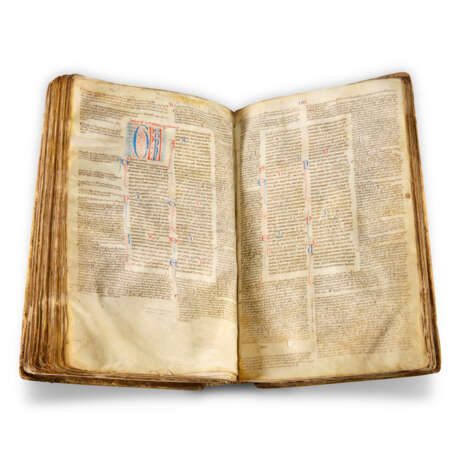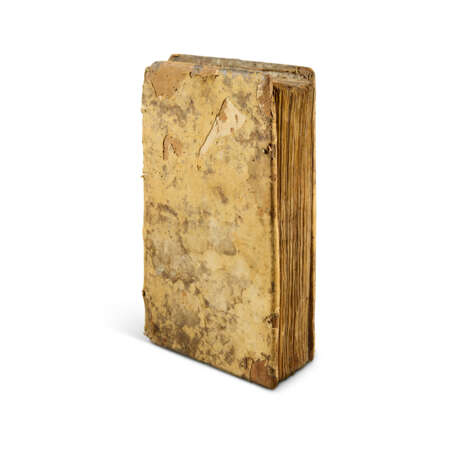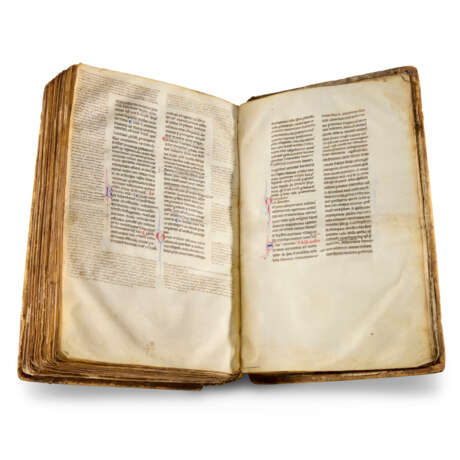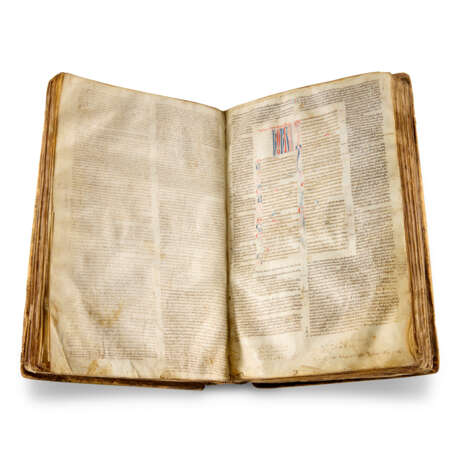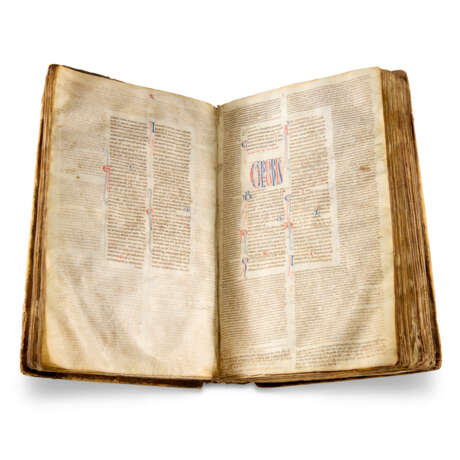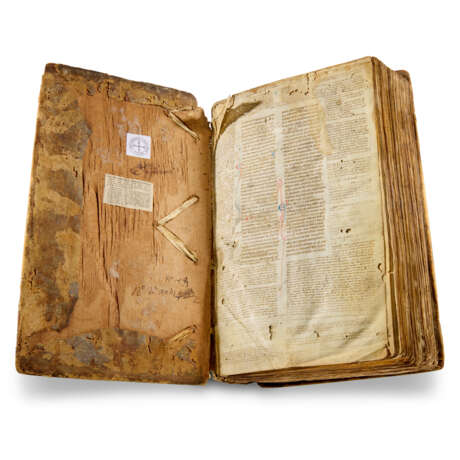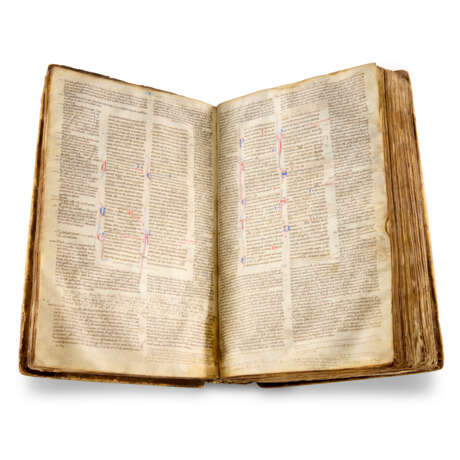ID 1214836
Лот 18 | The Decretals
Оценочная стоимость
£ 30 000 – 50 000
Pope Gregory IX, (c.1145-1241), Decretales Gregorii IX, with gloss of Bernardo Bottoni of Parma, and Innocent IV (1195-1254), Novellae Constitutiones, with gloss of Bernard of Compostella junior, in Latin, decorated manuscript on vellum [Italy, probably Bologna, 3rd quarter 13th century]
An imposing folio manuscript of the most important legal textbook of the 13th century, in its original binding, and with extensive glosses and annotations.
380 x 230mm. 252 leaves, collation: 16 (of 8, lacking i-ii), 28, 34, 48, 54, 6-118, 126, 13-158, 162, 17-278, 286, 29-318, 326, 3310, 348, catchwords sporadically survive, the main text 41-42 lines in two columns, ruled space: 195 x 110mm, surrounded by very extensive gloss in smaller script mostly around 3 sides of each column, headings in red, running-titles and one-line initials throughout alternately in red and blue, larger flourished penwork initials throughout alternately blue and red with penwork in the contrasting colour, 4 large decorated book openings formed of the name 'Gregorius' in tall combined capitals the width of the column (ff.58, 111 - with the initial 'G' left blank - 163v and 182v), extensive medieval notes and added glosses on every page in different hands, some slips of vellum bound in with further glosses (lacking two leaves at the beginning and a few leaves at the end, signs of considerable use over several centuries, some pages torn and frayed, a section torn from f.66 with loss of text, margins cut away from ff.247-8 and 251 with loss of some text or gloss, some worming at ends).
Binding:
Contemporary binding of rounded wooden boards sewn on 4 tawed leather thongs pegged into V-shaped patterns in the boards, covered with brown leather, pastedown inside lower cover from part of a 15th-century document in a French notarial hand, traces of 4 clasps once on edges of upper cover, one metal catch remaining on upper edge of lower cover of lozenge-shape stamped with the Paschal Lamb and the letter 'S' (worn and wormholed, covering partly defective especially over spine).
Provenance:
(1) It seems probable that the vast majority of law books like this were made in Bologna, and were either sent out from there for sale or were used by law students attending lectures at the university and brought home on completion of their studies. The present manuscript was in France by the 15th century, to judge from the script of some added notes, the name 'francoys' scribbled on f.187, and the pastedown from a French document.
(2) Denys de Salvaing de Boissieu (1600-1683), of Vourey, judge and historian. Sold at Grenoble at the sale of his library by M. Falque and Felix Perrin, Catalogue d'une Importante Bibliothèque composée d'ouvrages anciens, rares et précieux - Ancienne Bibliothèque de D. de Salvaing de Boissieu, Grenoble, 13-18 December 1897, lot 234. The description from this catalogue is pasted into the inside upper cover.
(4) Sotheby's, 5 December 1995, lot 32.
(5) The Schøyen Collection, MS 2084.
Content:
Gregory IX, (c.1145-1241), Decretales Gregorii IX: Book I (lacking opening), beginning in Tit. II, Cap.VIII: '[...] evidenter quod apparet', ff.1-57v; Books II ff.58-109v; Book III ff.111-163; Book IV ff.163v-182v; Book V f.182v-234v, ending: '[...] hommagium conpellatur. amen'; Innocent IV (1195-1254), Novellae Constitutiones, beginning 'De rescriptis / Cum in multis iuris articulis [...]', ff.235-252v.
The Decretals of Gregory IX became the fundamental text of canon law, which controlled many aspects of secular as well as clerical life. This was what the Pope intended when in 1230 he ordered his confessor, Raymond of Peñafort, to organise into one authoritative text the existing five compilations of canon law with their subsequent additions, including his own. In 1234 the Pope sent the new work to the universities of Paris and Bologna and decreed that this was henceforth to be the official collection. Innocent IV expanded the Decretals with his own canons, known as the 'Novellae'. The marginal annotations show that the present copy continued to be used well into the 15th century (indeed it was owned by a French lawyer and judge in the 17th century).
Such a crucial text rapidly acquired commentators, with the Glossa Ordinaria, completed c.1266, being the most popular gloss as opposed to independent commentary. The substantial commentary here is that of the jurist Bernardo Bottoni of Parma (d.1266), who studied in Bologna under Tancred. The commentary of the Novellae Constitutiones is that of Bernard of Compostela junior, chaplain to pope Innocent IV. The uniformity of text, essential for law operative throughout western Christendom, was reflected in comparatively uniform layouts and systems of decoration. The penwork title panels with the name Gregorius and the flourished initials, found in volumes from both Italy and northern Europe, are part of a carefully ordered articulation of text and gloss designed for ease of use. For more on the Decretals, see S. L'Engle and R. Gibbs, Illuminating the Law, Legal Manuscripts in Cambridge Collections, 2001, esp. pp.15-19, 69-71.
Comparatively few copies of this essential text remain in private hands.
| Место происхождения: | Италия, Европа |
|---|---|
| Категория аукционного дома: | Книги и рукописи |
| Место происхождения: | Италия, Европа |
|---|---|
| Категория аукционного дома: | Книги и рукописи |
| Адрес торгов |
CHRISTIE'S 8 King Street, St. James's SW1Y 6QT London Великобритания | |
|---|---|---|
| Предосмотр |
| |
| Телефон | +44 (0)20 7839 9060 | |
| Комиссия | see on Website | |
| Условия использования | Условия использования |
